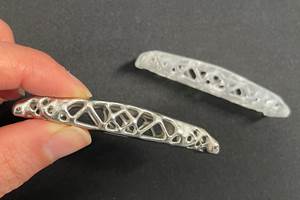Plating Q&A: Controlling Cleaners
Coventya’s Brad Durkin explains how to improve the control of cleaners on the process line.
Q. How can we improve the control of my cleaners on the process line?
A. Three titration methods can be used to track cleaner concentration and indicate soil loading. These three titrations are effective for all alkaline cleaners that use phenolphthalein to maintain concentration. Generally, the cleaner sample size is 10 ml and titrated against 1.0 N acid. These values may be different, but as long as they are consistent for all titrations, they can be a good gage for solution performance.
These titrations must start with a fresh cleaner make-up or standard cleaner solution made up in the lab and continued until the bath is no longer functional. These values can then be used to approximate the disposal point for the next bath, provided the soils are relatively consistent.
Day-to-day testing of the initial bath should reveal a decrease in free caustic and an increase in total alkalinity. When plotted along with the reject count, provided all else is constant, a point will be determined where the reject rate is unacceptable. This can then be tied to a failure point for the total alkalinity level. The next cleaning tank solution can then be monitored until it approaches this failure level and should be replaced before it reaches this point.
As an example, an applicator was experiencing difficulties with higher rejects from poor cleaning. A sample of the soak cleaner was analyzed using the three indicators approach. For comparative purposes, a lab batch of the same cleaner was made up at the same phenolphthalein endpoint concentration when titrated against 1.0 normal acid for the production bath. Here are the results:
|
Titration Indicator |
Lab Batch |
Process Tank |
|
Azo violet endpoint |
2.8 ml |
0 ml |
|
Phenolphthalein |
3.4 ml |
3.4 ml |
|
MRBCG mixed indicator |
3.8 ml |
6.0 ml |
What insight about the cleaning does this data reveal? Generally, the free alkalinity phenolphthalein titration will remain constant because it is being used to maintain concentration. As this titration value decreases, fresh cleaner is added to maintain the concentration. A problem with the phenolphthalein endpoint is that alkaline cleaners formulated with sodium hydroxide have an affinity to absorb carbon dioxide from the air over time and with use. The older the cleaner, the more carbon dioxide absorbed. This absorption forms sodium carbonate that contributes to this titration value. The problem is that as sodium hydroxide is used up or converted to carbonate, the phenolphthalein titration value stays the same or increases. This signifies a loss in cleaning efficiency, while the titration shows there is enough cleaner to be effective. Carbonate is not a good builder for improving the cleaning efficiency.
The free caustic titration, measured by azo violet, will generally decrease in spite of the cleaner additions. This occurs because a proportionally larger amount is being used to neutralize fatty acids and react with other soils. An azo violet titration value much less than the lab batch value indicates that the free sodium hydroxide formulated into the cleaner has been consumed, which is often the case. Here, the value is zero, which represents no available alkalinity for improving cleaning efficiency. Since many soils are more easily removed when free sodium hydroxide is present, a significant decrease in detergency with a resulting decrease in cleaning ability can be expected when this value is lower than optimum.
A high MRBCG mixed indicator titration, measuring total alkalinity, is indicative of high levels of contamination from ingredients of soils that also contribute to this titration. Examples of these types of soils are soaps, fatty acids, fatty oils and amines. Even though the insoluble soils are being removed from the work, some soluble portions of these soils are accumulating and making it difficult for the cleaner to perform. As the contaminants build-up, the cleaning efficiency will fail at a certain point. An arbitrary point appears to be where this titration doubles from its original value. Naturally, some soils are easy to remove and the cleaner will function at a higher level of contamination while other soils are more difficult to remove and the cleaner will cease to function at a value less than the arbitrary point. A reduction in detergency is usually the result of too high a value.
Brad Durkin is the director of international product management for Coventya. He can be reached at b.durkin@coventya.com
Originally published in the December 2015 issue.
Related Content
Possibilities From Electroplating 3D Printed Plastic Parts
Adding layers of nickel or copper to 3D printed polymer can impart desired properties such as electrical conductivity, EMI shielding, abrasion resistance and improved strength — approaching and even exceeding 3D printed metal, according to RePliForm.
Read MoreHow to Maximize Nickel Plating Performance
The advantages of boric acid-free nickel plating include allowing manufacturers who utilize nickel plating to keep up the ever-changing regulatory policies and support sustainability efforts.
Read MoreChoosing and Troubleshooting Copper Electroplating Processes
Learn more on this inexpensive and highly efficient process.
Read MoreCleaning, Pretreatment to Meet Medical Specs ISO 13485 or FDA 21 CFR820
Maximilian Kessler from SurTec explains new practices for industrial parts cleaning, metal pretreatment and decorative electroplating in the medical device industry.
Read MoreRead Next
Powder Coating 4.0: Smarter, Faster, More Efficient and Connected
New tools reduce cost and waste, lower manufacturing footprint of powder coating operations.
Read MoreThe 2024 Ford Mustang: All the Colors Available
Although Chevrolet has announced the end of the Camaro and Dodge is offering “Last Call” editions of the Charger and Challenger, the Ford Mustang is launching to its seventh generation.
Read MoreEpisode 42: An Interview with Robin Deal, Hubbard-Hall
Hubbard-Hall wastewater treatment specialist Robin Deal discusses the latest trends in wastewater management.
Read More

























